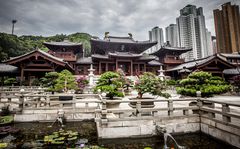Nan Lian
Nan Lian 南蓮 | |
|---|---|
Special municipality | |
 | |
| Country | |
| Province | |
| City founded | November 14, 2006 |
| Government | |
| • Type | Municipality |
| Area | |
| • Total | 3.5 km2 (1.4 sq mi) |
| Population | |
| • Total | 46 |
| Time zone | (UTC+8) |
| Capital city of Taihan | |
Nan Lian, (Traditional Han: 南蓮; Jyutping: Naam Lin) officially known as Nan Lian City, is the capital city and a special municipality of Taihan. It is the seat of the Emperor of Taihan and the Taihanese government. Despite being the capital city and seat of government of Taihan, most of the area is claimed but uncontrolled by the Taihanese authorities, however, Nan Lian City is sometimes considered as a ceremonial capital of Taihan. The name "Nan Lian" can refer either to the whole municipality area or the city proper.
History
Early history
On 14 November 2006, Nan Lian was first opened to the public and it served as a Chinese Classical Garden. It designed in the Tang Dynasty-style with hills, water features, trees, rocks and wooden structures.
As capital city of Taihan
On 17 July 2010, the Jiuhong Emperor announced the creation of Taihan and proclaimed the Cantonese Empire at Chi Lin Nunnery, later claimed as the Imperial Palace, this was not approved by Hong Kong SAR Government. On February 2011, the enthronement of the Jiuhong Emperor took place at the Temple of Heaven, the Emperor was arrested by the Hong Kong Police Force for disturbing the peace.
In 2012, the city's claim expanded beyond nearly half of Diamond Hill.
Demographics

Nan Lian's population is estimated at around 46. Nan Lian's society is linguistically and culturally homogeneous, composed of 98.5% Taihanese, with small populations of foreign workers.
Religion

(Claimed but uncontrolled)
Upper estimates suggest that 84–96 percent of the Nan Lian population subscribe to Taoism, Confucianism, Folk religion or Buddhism, including a large number of followers of a syncretism of these four religions. However, these estimates are based on people affiliated with a temple, rather than the number of true believers. Other studies have suggested that only 30 percent of the population identify themselves as belonging to a religion.
Demographically, the most widespread religious tradition is the folk religion, which overlaps with Taoism, and describes the worship of the shen (神), a character that signifies the "energies of generation". The shen comprises deities of the natural environment, gods representing specific concepts or groups, heroes and ancestors, and figures from Taihanese mythology.
Among the most popular folk cults are those of Mazu (goddess of the seas), Huangdi (one of the two divine patriarchs of the Han race), Guandi (god of war and business), Caishen (god of prosperity and richness), Pangu and many others.
Education
The education system roughly follow the system in England, although international systems exist. The government maintains a policy of "mother tongue instruction" (Cantonese: 母語教學) in which the medium of instruction is Cantonese, with written Chinese and English, while some of the schools are using English as the teaching language. In secondary schools, 'biliterate and trilingual' proficiency is emphasised, and Mandarin-language education has been increasing.
The system features a non-compulsory three-year kindergarten, followed by a compulsory six-year primary education, a compulsory three-year junior secondary education, a non-compulsory two-year senior secondary education leading to the Nan Lian Certificate of Education Examinations and a two-year matriculation course leading to the Nan Lian Advanced Level Examinations. The Minister of Education declared the New Senior Secondary academic structure and curriculum in 2012, which provides for all students to receive three years of compulsory junior and three years of compulsory senior secondary education. Under the new curriculum, there is only one public examination, namely the Nan Lian's Diploma of Secondary Education.